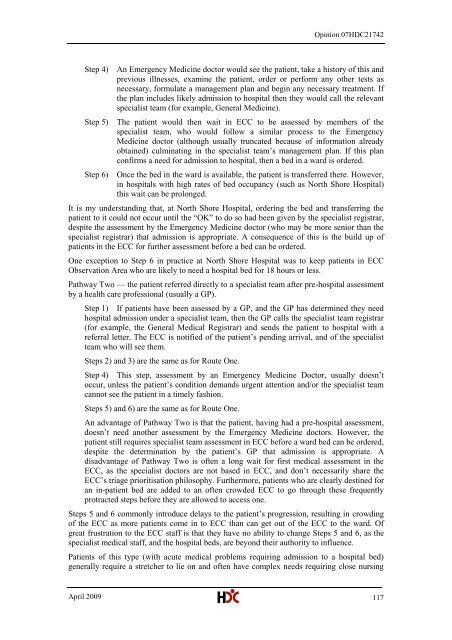North Shore Hospital report - New Zealand Doctor
North Shore Hospital report - New Zealand Doctor
North Shore Hospital report - New Zealand Doctor
Create successful ePaper yourself
Turn your PDF publications into a flip-book with our unique Google optimized e-Paper software.
Opinion 07HDC21742Step 4) An Emergency Medicine doctor would see the patient, take a history of this andprevious illnesses, examine the patient, order or perform any other tests asnecessary, formulate a management plan and begin any necessary treatment. Ifthe plan includes likely admission to hospital then they would call the relevantspecialist team (for example, General Medicine).Step 5) The patient would then wait in ECC to be assessed by members of thespecialist team, who would follow a similar process to the EmergencyMedicine doctor (although usually truncated because of information alreadyobtained) culminating in the specialist team‘s management plan. If this planconfirms a need for admission to hospital, then a bed in a ward is ordered.Step 6) Once the bed in the ward is available, the patient is transferred there. However,in hospitals with high rates of bed occupancy (such as <strong>North</strong> <strong>Shore</strong> <strong>Hospital</strong>)this wait can be prolonged.It is my understanding that, at <strong>North</strong> <strong>Shore</strong> <strong>Hospital</strong>, ordering the bed and transferring thepatient to it could not occur until the ―OK‖ to do so had been given by the specialist registrar,despite the assessment by the Emergency Medicine doctor (who may be more senior than thespecialist registrar) that admission is appropriate. A consequence of this is the build up ofpatients in the ECC for further assessment before a bed can be ordered.One exception to Step 6 in practice at <strong>North</strong> <strong>Shore</strong> <strong>Hospital</strong> was to keep patients in ECCObservation Area who are likely to need a hospital bed for 18 hours or less.Pathway Two — the patient referred directly to a specialist team after pre-hospital assessmentby a health care professional (usually a GP).Step 1) If patients have been assessed by a GP, and the GP has determined they needhospital admission under a specialist team, then the GP calls the specialist team registrar(for example, the General Medical Registrar) and sends the patient to hospital with areferral letter. The ECC is notified of the patient‘s pending arrival, and of the specialistteam who will see them.Steps 2) and 3) are the same as for Route One.Step 4) This step, assessment by an Emergency Medicine <strong>Doctor</strong>, usually doesn‘toccur, unless the patient‘s condition demands urgent attention and/or the specialist teamcannot see the patient in a timely fashion.Steps 5) and 6) are the same as for Route One.An advantage of Pathway Two is that the patient, having had a pre-hospital assessment,doesn‘t need another assessment by the Emergency Medicine doctors. However, thepatient still requires specialist team assessment in ECC before a ward bed can be ordered,despite the determination by the patient‘s GP that admission is appropriate. Adisadvantage of Pathway Two is often a long wait for first medical assessment in theECC, as the specialist doctors are not based in ECC, and don‘t necessarily share theECC‘s triage prioritisation philosophy. Furthermore, patients who are clearly destined foran in-patient bed are added to an often crowded ECC to go through these frequentlyprotracted steps before they are allowed to access one.Steps 5 and 6 commonly introduce delays to the patient‘s progression, resulting in crowdingof the ECC as more patients come in to ECC than can get out of the ECC to the ward. Ofgreat frustration to the ECC staff is that they have no ability to change Steps 5 and 6, as thespecialist medical staff, and the hospital beds, are beyond their authority to influence.Patients of this type (with acute medical problems requiring admission to a hospital bed)generally require a stretcher to lie on and often have complex needs requiring close nursingApril 2009 117
















